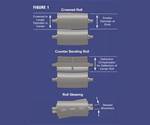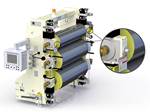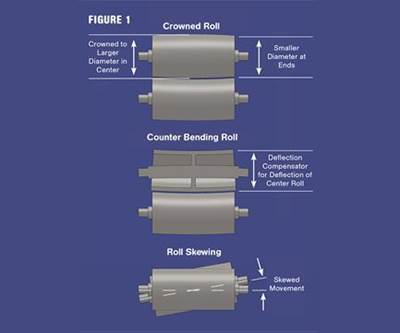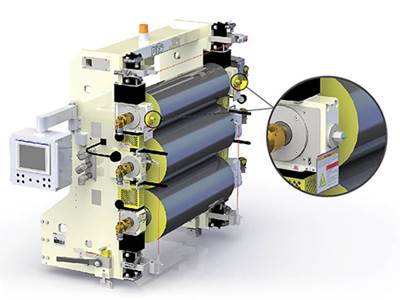How to Select the Right Cooling Stack for Sheet
First, remember there is no universal cooling-roll stack. And be sure to take into account the specific heat of the polymer you are processing.
Extruded plastics are cooled in a variety of ways—by water, air, and chill rolls. Chill-roll cooling has the most easily definable cooling calculation, but I still see considerable ambiguity when it comes to the selection of roll stacks for sheet.
For sheet extrusion it’s common to have some geometric variation of a three-roll vertical stack, with possibly some additional rolls for very high-speed lines where the contact time is short. In sheet, the top roll has only a minor cooling effect because the polymer has a small contact area.
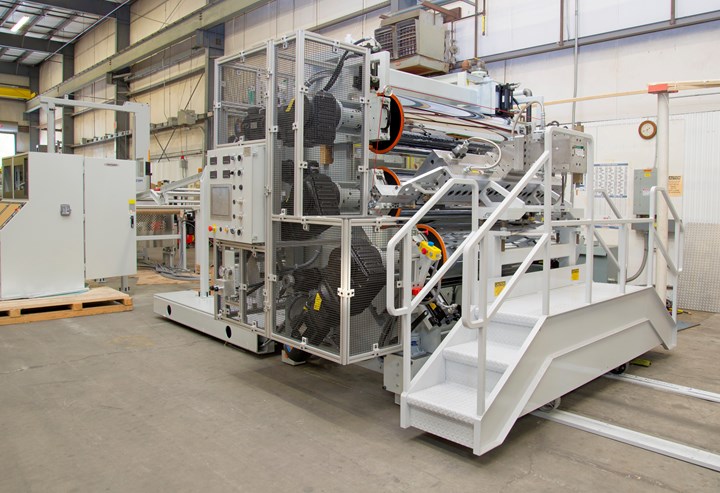
J-Stack designs like this one are typically used for PET, PETG, PS, and PP. (Photo: Davis-Standard)
There are four main things to consider in selecting the correct stack for your application: the overall cooling capacity, the products to be processed, the mechanical capability, and the rolls’ internal design. Considering just the cooling capacity, the top roll is there to set the sheet thickness as well as its uniformity. Typically, less than 10% of the roll is in contact with the plastic, minimizing the area for heat transfer. The middle roll does most of the cooling because it has about half its circumference covered with the polymer and the plastic is hottest there, maximizing the heat transfer to the cooled roll. The third roll also has 50% or more of its circumference in contact with the plastic, but since a lot of the heat in the plastic went into the middle roll the heat-transfer rate is usually much less for the third roll. However, since the third roll cools the opposite side of the sheet from the middle roll, it becomes more effective for thicker sheets. It takes time for heat to move through the sheet, and the thicker the sheet the lower the percentage extracted on one particular roll.
There are quite a few considerations for the proper roll sizing, based just on the different polymer properties. That is, there is no universal roll set. The roll’s cooling effectiveness varies with the type of polymer, the roll design and the coolant. I will stick to the polymer differences in this article, as they have a significant effect on the cooling. The heat-transfer rate, specific heat and melt temperature are the major determinants of the cooling rate.
Let’s consider a line processing HIPS compared with one processing HDPE, with both having the same melt temperature of 375 F and a desired exit temperature of 120 F. So 375-120 = 255° F cooling in both cases, but if you multiply that by the specific heat of the polymer, the results are quite different.
HIPS: 255 F × 0.32 BTU/lb-°F = 81.6 BTU/lb
HDPE 255 F × 0.55 BTU/lb-°F = 140.3 BTU/lb
There is 72% more heat to be removed from the HDPE at the same output rate (lb/hr). However, the rate of heat transfer in HDPE is more than double that of HIPS. So even though there is more heat to be transferred with the HDPE, it moves through the sheet more than twice as fast from the polymer to the roll surface. While that means it’s possible cool these two polymers at similar rates, the HDPE would require more coolant flow for that to happen.
Now let’s compare HDPE with PP:
PP: 255 F × 0.52 BTU/lb-°F = 132.6 BTU/lb
HDPE: 255 F × 0.55 BTU/lb-°F = 140.3 BTU/lb
They are very close in heat content (0.55 vs. 0.52 BTU/lb-°F) but the heat transfer rate of PP is 60% of that of HDPE (0.15 vs. 0.09 BTU/Ft-Hr-°F). That means that under the same conditions of output, roll temperature and melt temperature, it will take 60% more time on the rolls to obtain the same exit temperature for the PP as the HDPE.
In addition to those properties, the melt density comes into play when the comparisons are based on pounds per hour. In the case of HIPS vs. HDPE, the HIPS melt is 33% more dense, so that the heat has a shorter distance to travel, eliminating half the advantage in heat-transfer rate for HDPE. In the PP/HDPE comparison, the PP has a slightly lower melt density than the HDPE, so that the heat has a slightly greater distance to travel, worsening the comparison.
Heat-transfer rate, specific heat and melt temperature are the major determinants of the cooling rate.
The point of this discussion is that there is no “universal” roll cooling equipment because of the differences in the polymer thermal properties. Even the melt density of the polymer affects the effectiveness of the roll cooling due to the differences in heat-transfer rate. When the polymer thermal properties are coupled with the mechanical requirements, the roll design/size and the roll cooling system, the selection of the roll stack becomes quite a complex issue.
This is particularly important in foreign-made or used equipment, where a knowledgeable OEM’s expertise may not be available. Be certain when buying new or used equipment that someone can evaluate the roll cooling for your exact application(s).
ABOUT THE AUTHOR: Jim Frankland is a mechanical engineer who has been involved in all types of extrusion processing for more than 50 years. He is now president of Frankland Plastics Consulting, LLC. Contact jim.frankland@comcast.net or (724)651-9196.
Related Content
The Effects of Time on Polymers
Last month we briefly discussed the influence of temperature on the mechanical properties of polymers and reviewed some of the structural considerations that govern these effects.
Read MoreImproving Twin-Screw Compounding of Reinforced Polyolefins
Compounders face a number of processing challenges when incorporating a high loading of low-bulk-density mineral filler into polyolefins. Here are some possible solutions.
Read MoreThree Key Decisions for an Optimal Ejection System
When determining the best ejection option for a tool, molders must consider the ejector’s surface area, location and style.
Read MoreThe Fundamentals of Polyethylene – Part 2: Density and Molecular Weight
PE properties can be adjusted either by changing the molecular weight or by altering the density. While this increases the possible combinations of properties, it also requires that the specification for the material be precise.
Read MoreRead Next
Extrusion: A Roll Is a Roll Is a Roll?
Chill rolls may looks simple and shiny, but they play a critical part in cooling and polishing film and sheet and are not all the same.
Read MoreSolving 10 Common Challenges In Extruding Thin-Gauge Sheet
Thin-gauge sheet production presents some unique challenges to the extrusion operator, including the following set of 10 commonly encountered considerations
Read More‘Skew’ Rolls for More Uniform Sheet
New feature aimed at thin-gauge PP sheet.
Read More
.jpg;width=70;height=70;mode=crop)

